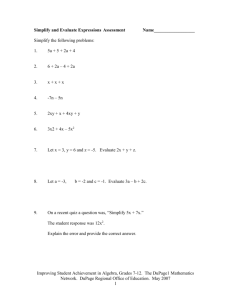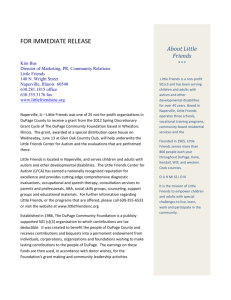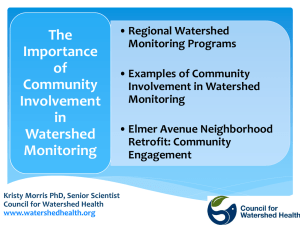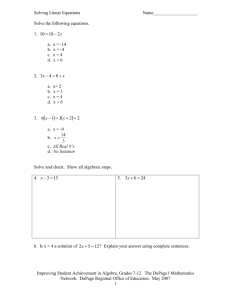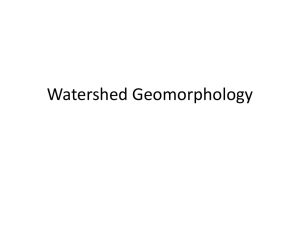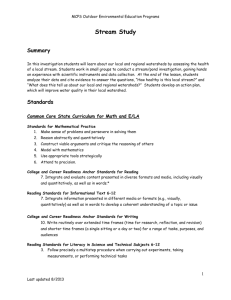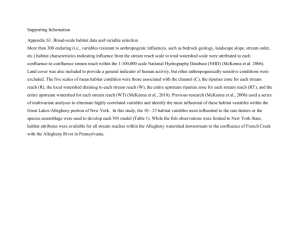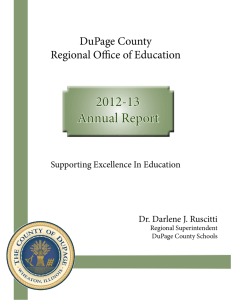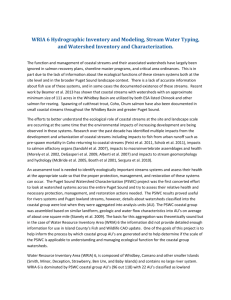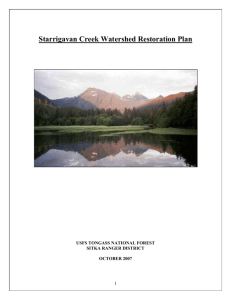The Situation
advertisement
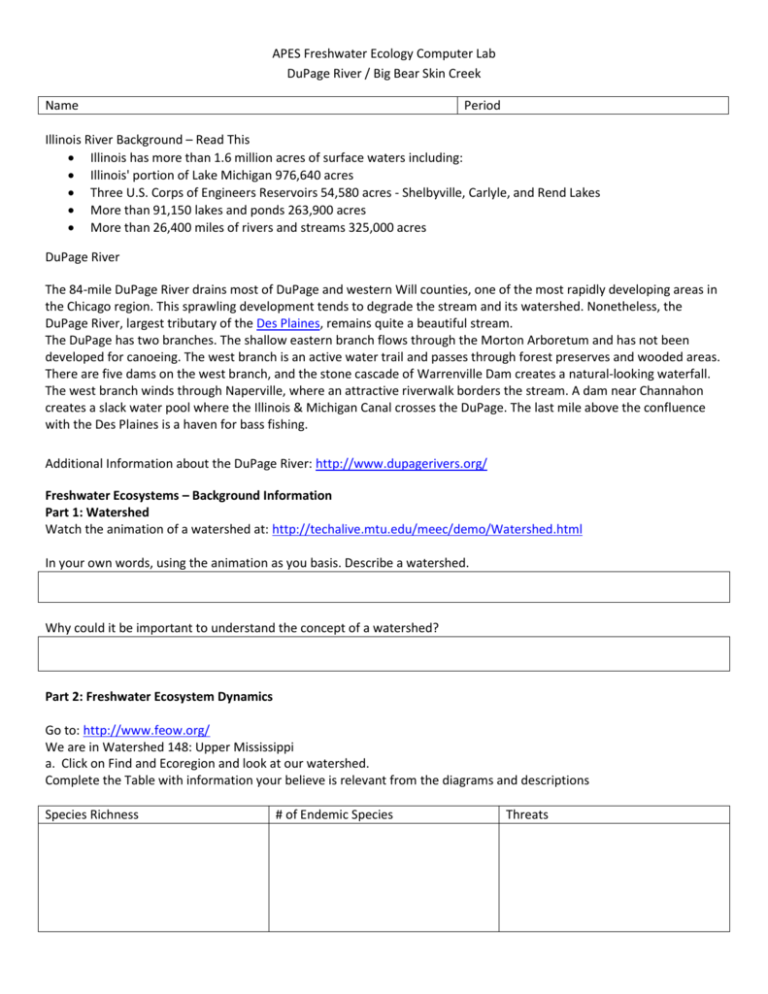
APES Freshwater Ecology Computer Lab DuPage River / Big Bear Skin Creek Name Period Illinois River Background – Read This Illinois has more than 1.6 million acres of surface waters including: Illinois' portion of Lake Michigan 976,640 acres Three U.S. Corps of Engineers Reservoirs 54,580 acres - Shelbyville, Carlyle, and Rend Lakes More than 91,150 lakes and ponds 263,900 acres More than 26,400 miles of rivers and streams 325,000 acres DuPage River The 84-mile DuPage River drains most of DuPage and western Will counties, one of the most rapidly developing areas in the Chicago region. This sprawling development tends to degrade the stream and its watershed. Nonetheless, the DuPage River, largest tributary of the Des Plaines, remains quite a beautiful stream. The DuPage has two branches. The shallow eastern branch flows through the Morton Arboretum and has not been developed for canoeing. The west branch is an active water trail and passes through forest preserves and wooded areas. There are five dams on the west branch, and the stone cascade of Warrenville Dam creates a natural-looking waterfall. The west branch winds through Naperville, where an attractive riverwalk borders the stream. A dam near Channahon creates a slack water pool where the Illinois & Michigan Canal crosses the DuPage. The last mile above the confluence with the Des Plaines is a haven for bass fishing. Additional Information about the DuPage River: http://www.dupagerivers.org/ Freshwater Ecosystems – Background Information Part 1: Watershed Watch the animation of a watershed at: http://techalive.mtu.edu/meec/demo/Watershed.html In your own words, using the animation as you basis. Describe a watershed. Why could it be important to understand the concept of a watershed? Part 2: Freshwater Ecosystem Dynamics Go to: http://www.feow.org/ We are in Watershed 148: Upper Mississippi a. Click on Find and Ecoregion and look at our watershed. Complete the Table with information your believe is relevant from the diagrams and descriptions Species Richness # of Endemic Species Threats b. Go to Global Maps → Summary Biodiversity Maps. Look at the different maps and draw some conclusions about U.S. Watersheds and the Global Watersheds. Look for tends and patterns on the maps. Be prepared to discuss in class. United States Global c. Go to Global Maps → Summary Threat & Status Maps Look at the different maps and draw some conclusions about U.S. Watersheds and the Global Watersheds. Look for tends and patterns on the maps. Be prepared to discuss in class. United States Global Part 3: Steam Physical Characteristics a. Evolution of a Meandering Stream Go to: http://www.wwnorton.com/college/geo/egeo/flash/14_1.swf Describe how a stream meanders over time. Make a guess why deposition occurs in some spots and erosion in others. Deposition Erosion Part 3 Continues: b.Riparian Zone Go to: http://www.in.gov/dnr/forestry/files/riparianzonemanagement.pdf or http://www.ehow.com/list_5745343_riparian-zone-important_.html What is a riparian zone and why is it important? Description Importance Additional Resource – Ecology of Running Water http://www.forestencyclopedia.net/p/p1/p1369/p1446/p1482 Part 4: Stream Chemical Characteristics The Situation The scarcity of clean surface water was once a concern primarily of state and federal agencies. Recently it has attracted the attention of local communities. Community members are turning to environmental consulting companies such as yours for advice. Your company - Earth, Wind, and Water, Inc. - has helped many public agencies and private businesses in the small town of Oak View. Earth, Wind, and Water, Inc. monitors environmental quality. It develops practices that environmentally and economically benefit Oak View. Your newest client, Mr. Charles Taylor, owns Taylor's Trout-A-Rama. Taylor's Trout-A-Rama is a local streamside catch-and-release campsite. Mr. Taylor is upset over the fact that the fish in that stretch of Bear Creek have been dying. His buisness, like the trout, is going belly-up. He has called on your firm to figure out what is killing the fish in that section of Bear Creek, and how to stop it. Go to: http://www.cotf.edu/ete/modules/waterq3/WQmain.html Use the information on this site to solve the problem. Summarize your methods and results in the table. Facts and Key Information Proposed Solutions to Problem Additional Chemical Water Quality Resources: http://ga.water.usgs.gov/edu/waterquality.html http://water.epa.gov/type/rsl/monitoring/stream_index.cfm http://www.ecy.wa.gov/programs/wq/plants/management/manual/index.html Part 5: Stream Biological Characteristics a. Use the same dichotomous key in this folder to identify each of the critters shown below. b. Use the links provided below and your skills as a researcher to help verify your answers and then complete the table for each benthic macroinvertebrate. Links: http://www.epa.gov/bioiweb1/html/invertclass.html http://www.dep.wv.gov/WWE/getinvolved/sos/Pages/Benthics.aspx http://www.epa.gov/bioiweb1/html/benthosclean.html http://www.dnr.state.md.us/education/envirothon/aquaticinsectecology.pdf Marcroinvertebrate Tables Species 1 Name Habitat Characteristics Adaptations Niche Additional Facts Species 2 Name Habitat Characteristics Adaptations Niche Additional Facts Species 3 Name Habitat Characteristics Adaptations Niche Additional Facts Species 4 Name Habitat Characteristics Adaptations Niche Additional Facts Species 5 Name Habitat Characteristics Adaptations Niche Additional Facts Part 5: Man’s Impact How does mankind and our footprint impact freshwater ecosystems? (use the links below for some help) Positive Impacts http://www.nature.org/initiatives/freshwater/features/watershed.html http://www.americanrivers.org/our-work/protecting-rivers/endangered-rivers/ http://www.dailyherald.com/story/?id=390688 Negative Impacts


